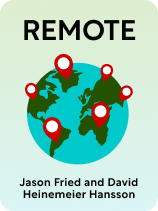

This article is an excerpt from the Shortform book guide to "Remote" by Jason Fried and David Heinemeier Hansson. Shortform has the world's best summaries and analyses of books you should be reading.
Like this article? Sign up for a free trial here.
Are you considering transitioning your workforce to remote work? How can you set your organization up for remote success?
In the book Remote, tech entrepreneurs Jason Fried and David Heinemeier Hansson present a case for work without physical boundaries. They argue that transitioning to remote work can be highly beneficial, but it can’t be done haphazardly.
Here’s how you can run a successful business with remote-only employees.
How Can You and Your Team Thrive When Working Remotely?
Even when everyone agrees that work doesn’t need to happen in a central office, successfully transitioning to remote work requires thoughtful planning. Fried and Hansson offer guidance for organizations transitioning to remote work and for individuals adapting to this different way of working.
Setting Your Organization Up for Remote Success
Shifting to remote work means rethinking how your team operates. Fried and Hansson highlight three critical areas to address: how you communicate, how you build culture, and who you hire.
1. Create Communication Systems That Actually Work
In an office, communication often happens naturally when you bump into someone in the hallway. In remote environments, you need to be more intentional about how your team shares information:
- Design channels with clear purposes. Specify which platforms you’ll use for different types of communication—project discussions, company announcements, casual chats—and set clear expectations about response times for each.
- Balance real-time and asynchronous communication. Mix video meetings and instant messaging with collaborative documents and project management tools. This combination supports different work styles and makes collaboration possible across time zones.
- Make documentation a habit, not an afterthought. Record decisions, discussions, and progress in shared spaces everyone can access. Good documentation keeps your entire team informed and creates valuable reference materials for current and future team members.
- Find your collaboration sweet spot. Establish core hours when everyone should be available for meetings and quick questions, while still giving people flexibility around these shared windows.
| The Nonverbal Gap: Why Remote Communication Requires New Skills While Fried and Hansson argue that remote workers can thrive when contributions are documented and evaluated objectively, neuroscience research reveals a significant challenge they don’t fully address: the “nonverbal gap.” Video communication removes crucial social signals our brains rely on: Micro-expressions become blurred, body language is partially hidden, and eye gaze patterns can’t be accurately tracked. These missing cues create a cognitive burden as our brains work overtime trying to compensate. In face-to-face interactions, we unconsciously process an intricate dance of nonverbal signals that establish trust, build rapport, and convey emotional states. Without these cues, remote workers have to deliberately create visibility through other means. Experts say remote workers can compensate for this nonverbal deficit—and make conversing via video chat feel more natural—with some deliberate practices: – Take important video meetings standing up to make more nonverbal cues visible – Position your camera at eye level and look directly at it when speaking to create the impression of eye contact – Nod, smile, and lean forward to signal engagement – Leverage platform features like the “raise hand” function and emoji reactions to communicate nonverbally – Eliminate distracting gestures or behaviors that signal disinterest (like visibly multitasking when other people are talking) |
2. Build a Remote-Friendly Culture
Strong culture doesn’t just happen—especially in remote teams. Fried and Hansson suggest focusing on doing the following:
- Measure what matters. Shift from tracking hours to evaluating outcomes. This builds trust and focuses attention on quality work rather than desk time.
- Provide the right tools. Equip your remote team with the technology, connectivity, and ergonomic support they need. These investments cost less than maintaining office space while showing your commitment to your workers’ success.
- Create in-person moments. Schedule occasional gatherings for relationship-building and collaborative planning to complement your day-to-day remote work.
- Celebrate wins consistently. Develop regular ways to recognize achievements and celebrate successes. This reinforces your values and maintains team spirit when people aren’t physically together.
| How Citizen Science Shows the Power of Remote Community The most effective remote cultures are built around shared purpose and meaningful work—a principle illustrated by citizen science programs like Happywhale, which has created a thriving global community united by a common mission. Happywhale uses AI-powered image recognition software to identify individual humpback whales by their unique tail (fluke) markings. But what makes this system truly powerful isn’t just the technology: It’s how it engages a global community of remote contributors. Professional researchers, tour guides, and casual whale watchers alike can upload photos of flukes to a central database, which now tracks more than 70,500 individual whales worldwide. This mirrors the principles Fried and Hansson recommend for remote work culture. Instead of measuring hours spent watching for whales, Happywhale measures meaningful outcomes: Each contributor receives notifications when “their” whale is spotted again, sometimes years later and thousands of miles away. While the program provides a simple app and website anyone can use, it also creates moments of connection through local presentations where participants can share their experiences, and it celebrates wins by highlighting notable discoveries—like tracking one whale’s extraordinary journey from Colombia to Tanzania. |
3. Hire People Who Will Thrive Remotely
Finding the right people makes all the difference in remote teams. Fried and Hansson recommend evaluating the following when hiring:
- Communication skills, especially in writing. Look for clarity, thoughtfulness, and efficiency in candidates’ writing, since most remote collaboration happens through text. Review their application materials and consider giving writing-based assignments during the hiring process.
- Self-direction. Seek people with the proven ability to work independently, prioritize effectively, and stay motivated without constant oversight. Previous remote work experience can be a plus, though it shouldn’t be a requirement.
- Cultural alignment. Use behavioral interviews and trial projects to assess how well candidates match your team’s values and work style, ensuring they’ll fit your specific remote environment.
| Finding Your Perfect Ensemble: Lessons From Asteroid City Just as director Wes Anderson assembles ensemble casts for the meticulously crafted worlds of his films, remote organizations must carefully select individuals who will thrive in their unique virtual environments. Anderson’s 2023 film, Asteroid City, offers a metaphor for remote work, having been created during the height of pandemic restrictions. The film’s structure—a play within a TV show within a movie—shows parallels to Fried and Hansson’s hiring recommendations. The characters exemplify the three essential traits of successful remote workers: First, exceptional communication skills, especially in writing. The playwright Conrad Earp (Edward Norton) must craft a script that resonates even when the performers don’t fully understand its meaning. When an actor struggles to make sense of the story, the director encourages him to keep going—an analog for remote workers who must communicate clearly even when facing ambiguity and uncertainty, as many people did when switching to remote work during the Covid-19 lockdowns. Second, self-direction. The film’s child characters demonstrate independence, developing scientific experiments without the oversight of adults. Similarly, the film’s actors (both the characters playing actors and the actual cast) show initiative within Anderson’s structured environment. The filming process required cast members to navigate physical spaces independently, and Scarlett Johansson described the process as more like acting for theater than for traditional filmmaking. Third, cultural alignment. Anderson’s quarantined production created an isolated environment in the desert, where team members organically aligned around shared values despite their diverse backgrounds. The film mirrors this with its assemblage of science-minded individuals and grieving characters, all processing their cosmic loneliness together—much like remote workers who must find connection despite physical isolation. The production discovered that isolation, paradoxically, fostered deeper connection: Musicians spontaneously performed after dinner, and the quarantine directly shaped the script’s themes. Similarly, effective remote teams transform constraints into opportunities for collaboration and creativity. As you build your remote team, seek candidates who, like Anderson’s ensembles, can navigate the space between isolation and connection—creating a troupe capable of communicating clearly, working independently, and embracing your organization’s unique culture, even when they don’t fully understand “the play.” |

———End of Preview———
Like what you just read? Read the rest of the world's best book summary and analysis of Jason Fried and David Heinemeier Hansson's "Remote" at Shortform.
Here's what you'll find in our full Remote summary:
- A breakdown of the many benefits of remote work
- Advice for organizations on how to transition from an in-person to a remote structure
- Why you don't have to sacrifice workplace culture in a remote company






